I spent a night at Azulik, the most famous hotel in Tulum. I wouldn’t go back.

Azulik is a stunning resort in the Tulum jungle, but it’s not worth staying the night.
“Reconnection” is a word that appears often on the website of Azulik, a luxury eco-resort nestled in the jungle of Tulum, Mexico.
It welcomes you to a “sanctuary for reconnection and wellness.” It promises spaces that were created for “reconnection and spiritual alignment.” And it instructs you to “reconnect with the wonderful ecosystems around you.”
Reconnection wasn’t what I found at Azulik’s famed sunset hour, where guests were glued to their phones as the sky changed from orange to gold. Nor was it at the resort’s beach club, where I spotted multiple camera tripods, or by my treehouse suite, where a security guard ensured no one got a free photo opportunity.
Azulik’s breathtaking scenery and treehouse suite made for some beautiful pictures, and my massage at the spa was heavenly. But from the hidden fees to the lackluster dining, I found a resort whose appeal mostly runs Instagram-deep.
Azulik didn’t respond to a request for comment.
Azulik is one of the most famous hotels in Tulum.

The Azulik resort features 48 villas, two on-site restaurants, and a private beach club.
Azulik’s picturesque rooftop and restaurants have become as ubiquitous to Tulum’s online image as the pink-and-white checkered swimming pool at Hotel Panamera or the swinging velvet chairs at Casa Malca. Celebrities such as Shay Mitchell and Kristin Cavallari have stayed in Azulik’s treehouse suites, and Vanessa Hudgens tied the knot at its nearby museum.
“I felt like I was transported to some kind of utopia, unlike anything I had ever been to before,” Hudgens told Vogue following her December 2023 wedding. “It was whimsical and magical, and I just fell in love.”
On my first two trips to Tulum, I drove by Azulik a number of times and was extremely intrigued by the idea of a candlelit luxury treehouse. So when I headed back in May to check out the brand-new Tulum airport, I knew exactly where I would stay.
Before I left for Tulum, I wanted to learn more about Azulik’s origins.
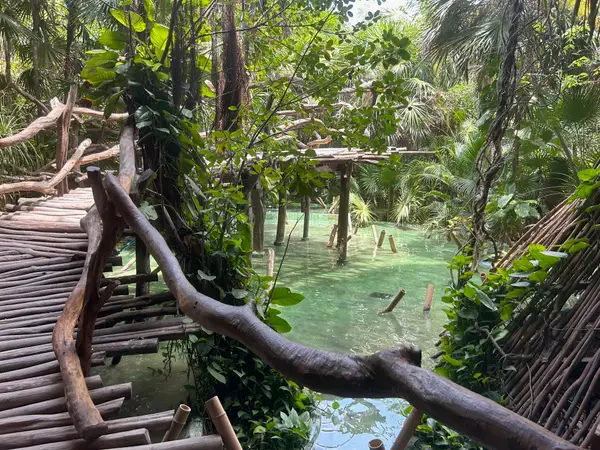
Tulum’s resort is connected via these unique suspended pathways, made of branches.
Azulik was dreamed up and designed by the architect Eduardo “Roth” Neira, who was hailed by Forbes in 2019 as “the hotelier seeking to save Tulum.” Dismayed with how Tulum’s landscape had been razed to build hotels for the growing influx of tourists, Roth set out to create a resort that would “reconnect people with the natural world.”
“We are destroying everything,” he told Forbes. “So what I tried to do is respect nature, and not cut any trees.”
Azulik’s restaurants and villas are connected via pathways made of linked logs suspended over the ground, meant to “make space for the animals to crawl below,” the resort’s website states. Their windy trails, which twist and turn around the jungle, are an intentional rejection of straight lines — “a human invention.” Lush trees and fauna provide a protective canopy around the resort, allowed to “continue their journey” in the jungle.
Call me a hopeless romantic or an easy target, but it all sounded poetic. Would the experience live up to its admirable origins?
My stay began in the check-in lounge, where I was immediately handed a clipboard with a two-page disclaimer.
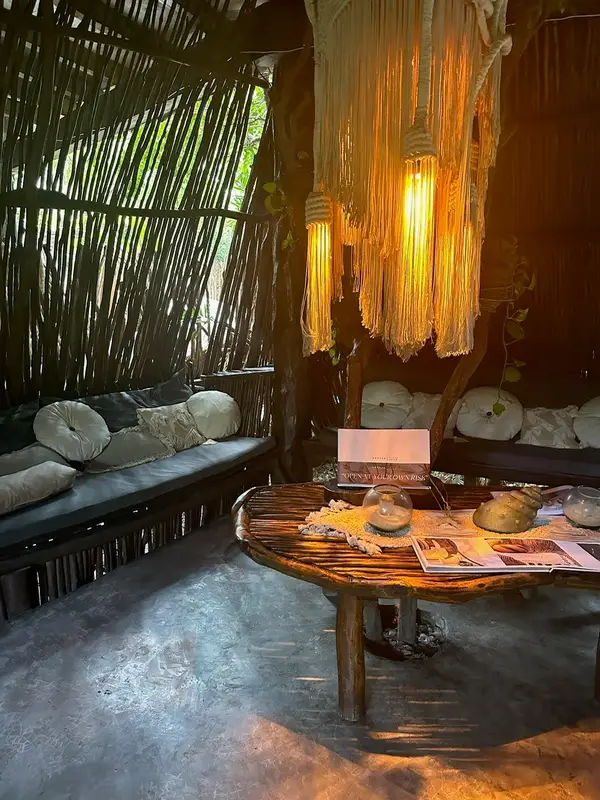
The lobby at Azulik.
Starting our stay with paperwork didn’t exactly scream luxury. It was quite different from the peaceful check-in process I had experienced two days earlier at La Valise, where my mom and I had been greeted with fresh margaritas.
But we dutifully carried our clipboards to a couch, where I began reading the disclaimer. It first noted that we were “assuming the risk of staying in a place surrounded by the lushness of the jungle” and advised that we do not come into contact with or feed the animals. Fair enough!
Then there were the fees: $20 in case we lost the “access control wristband” (a piece of string), $20 if we lost the magnetic key, and $200 for smoking. But most surprising was the note that it was strictly forbidden to use a professional camera within the hotel, the noncompliance of which could result in a charge of $15,000. By signing the disclosure, I authorized the resort to use my credit card on file for “the full payment of all charges.”
Even with no professional camera, I balked at the over-the-top fee. Welcome to Azulik.
Once our disclaimers were signed, it was time for a tour.
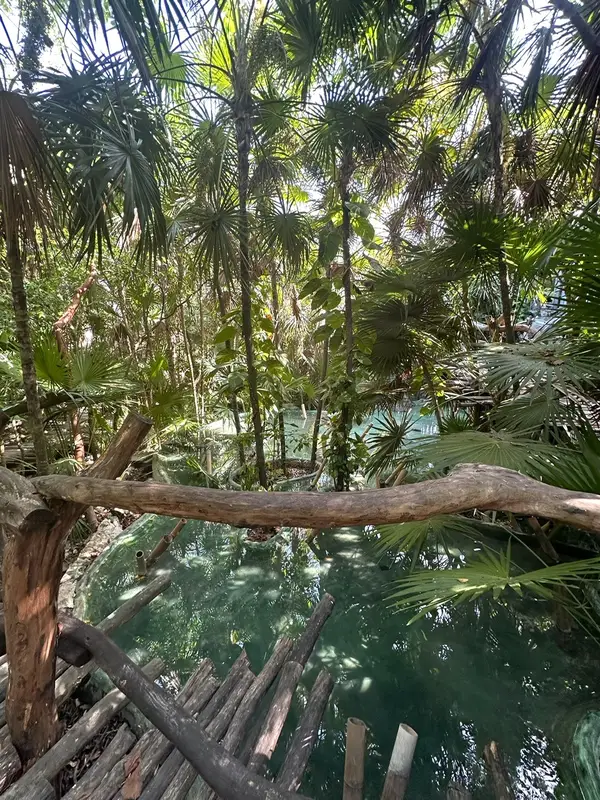
Waterways glisten under the suspended pathways throughout the resort.
A woman in a flowing Grecian dress introduced herself as one of Azulik’s “angels,” the term they use for their staff members.
As we left the dark lounge and walked out into the lush jungle, I was briefly struck by the resort’s beauty. The waterways throughout the hotel glistened under the sun, and the flourishing trees provided gorgeous scenery and comforting shade.
But as we began to walk around, I realized that the pathways were quite … bumpy. The curvy branches were of different sizes and lengths, creating an irregular floor. On its website, Azulik says this “invites us to pay attention to our every step.” It also notes that this is one of the reasons children aren’t permitted on the premises.
While I was fine to walk the pathways, my mom, who is in her 60s, struggled a bit. The website notes that the Azulik rooms are “not suitable for people with disabilities,” but the pathways could be tough even if you just have issues with your back or knees.
As we walked through one of the lounges, I stopped to check out the event schedule written on a chalkboard.

The activity board in an Azulik lounge showcased a range of classes and workshops.
Azulik has a range of activities for its guests, including daily vinyasa yoga at 8 a.m.
Workshops on ego masks, flower mandalas, and “healing the inner child” are also offered throughout the week.
Then, it was time for Azulik’s traditional “energy cleansing” welcome ceremony.

We had our welcome ceremony in this tent, standing on the wooden platform.
My mother and I dutifully waited as three friends handed their phones to one of the angels to take a video of them as the ceremony began. They stepped onto a wooden platform, grasped each other’s hands, and shut their eyes as a woman wafted incense around them. We learned that this ceremony was meant to help guide us into a state of deep relaxation and leave the negative energies and stress behind.
Once the tour was complete, we arrived at our treehouse villa.
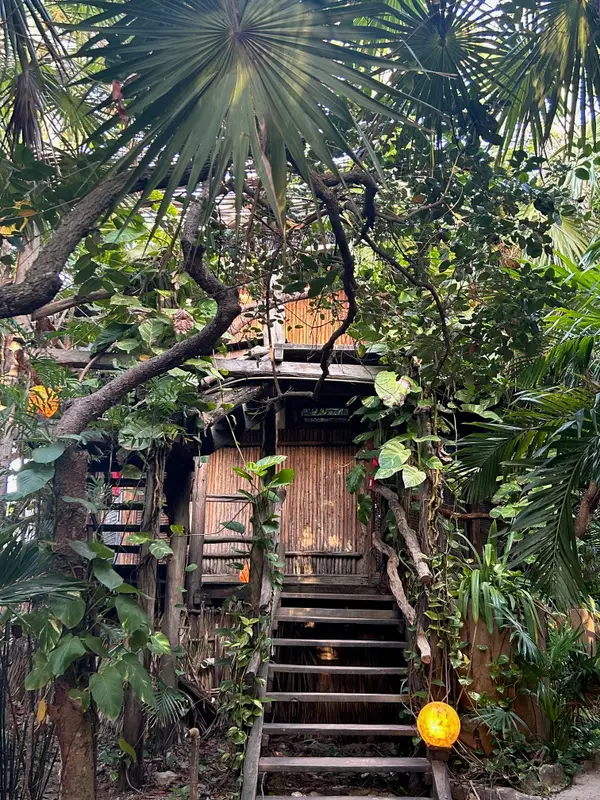
My villa for the night was framed with a lush of beautiful trees.
My mom and I stayed in the Mayan Villa, which cost $510 for one night during my May trip.
Room rates at Azulik can fluctuate widely depending on the villa you choose and when your trip is booked. The price tends to increase if you stay during Tulum’s peak season from December to April.
Our dreamy suite was one of my favorite parts of Azulik.

I paid $510 to spend a night in the Mayan Villa.
As we walked in, the room was drenched in sunlight, its many windows covered by blinds made from branches.
A round king bed stood in the center of the room. It was plush and cool, flanked by a gauzy mosquito net that hid a small ceiling fan. Our suite also had an air conditioner, a welcome reprieve as temperatures hit above 80 degrees.
You can find my full room tour at Azulik here.
Since the villa has no electric lights, there were candles spread throughout the space.
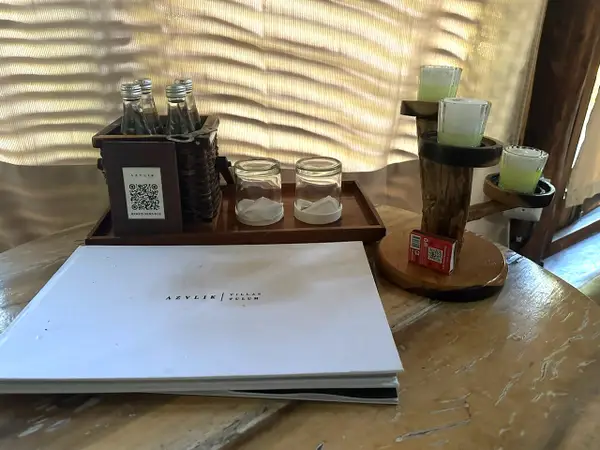
A staff member comes into each room to light the tea candles every night when the sun sets.
While every Azulik villa has WiFi and a power outlet to charge your phone, there are no lamps. Instead, a staff member comes by every night to light all the tea candles as the sun goes down.
According to its website, this is an intentional choice that Azulik hopes will “create an atmosphere of tranquility.” The resort also notes that it wanted to forego any “light pollution that severely impacts the environment of creatures like sea turtles.”
We were also surprised to find that there was no shower.

My room’s handmade mosaic bathtub.
Every villa at Azulik comes with a handmade mosaic bathtub. Its website says this is meant to encourage guests to “take your time, soak in the tub with bath salts, and relax.”
The beautiful mosaic bathtub, decorated with hand-painted blue flowers, matched the nearby sink. Half a coconut shell rested on the edge to help with bathing. The usual provided toiletries were available, but alas, no bath salts.
As my mom and I walked around the resort, we realized much of the space was dedicated to the spa.

We saw several pools, like the one above, which featured two massage beds set up for upcoming appointments.
Many of the beds overlooked the ocean, allowing guests to enjoy the sound of crashing waves during their services. It was a stunning setup that matched the unique design of the spa, which I got a full view of the following morning.
But I found it a bit strange that there were so many miniature pools dedicated to decoration when Azulik didn’t have an actual pool for guests to swim in. Tulum’s beaches are frequently covered in sargassum during its seaweed season (around May to October), so no pool seemed like a strange choice — especially for a luxury resort.
We then headed to the rooftop for Azulik’s famed sunset hour.
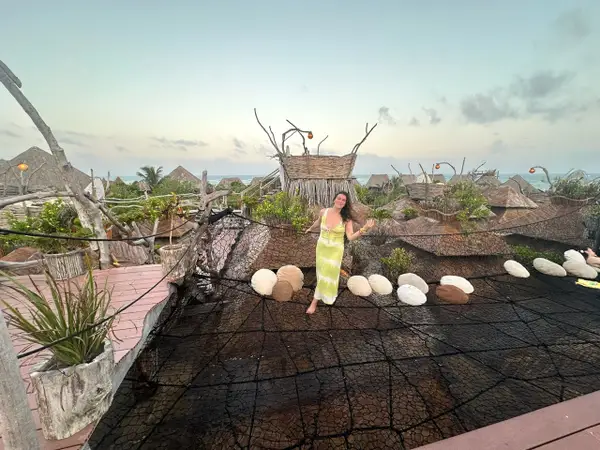
The rooftop had suspended nets, allowing you to sit over the resort.
Azulik’s daily sunset hour begins at 5 p.m., and there are no reservations — spots are given on a first-come, first-served basis. The experience is free for guests and $50 for the general public, which includes a complimentary drink.
After making our way up several staircases, we were met with the sounds of melodic techno. “This feels like Burning Man light,” I wrote in my notes as I spotted the moody DJ with a leopard-print pashmina slung over his head.
Despite being a popular event, only a few small tables were set up on the expansive roof. Most people stood and held their drinks, while some opted to lie down on the suspended nets over the trees.
Most of the seating was reserved for the private VIP “nests.”
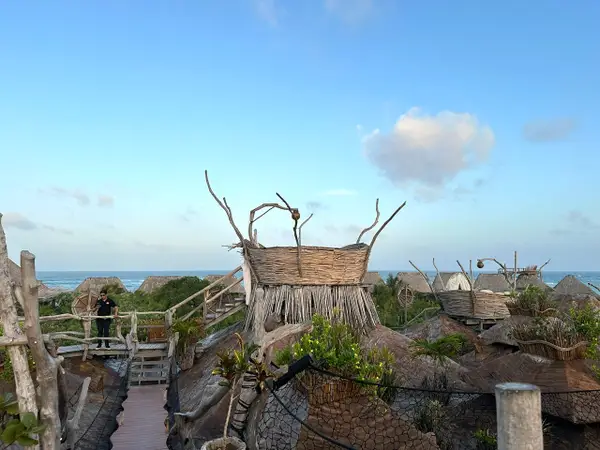
One of the nests on the rooftop at Azulik.
Depending on which table you reserve, the nests cost 10,000 to 12,000 Mexican pesos, or around $500 to $600, for eight to 12 people. The cost does not include food or drinks.
Every nest I saw on the rooftop was empty, save for one. It seemed like another instance in which profit had won over guests’ comfort.
The rooftop offered a 360-degree view of the jungle and the sea, which was undeniably stunning.

We caught a stunning sunset during the rooftop hour.
It was a beautiful sight, especially as the sun began to set and the sky shone gold.
We then made our way to Tseen Ja for dinner.
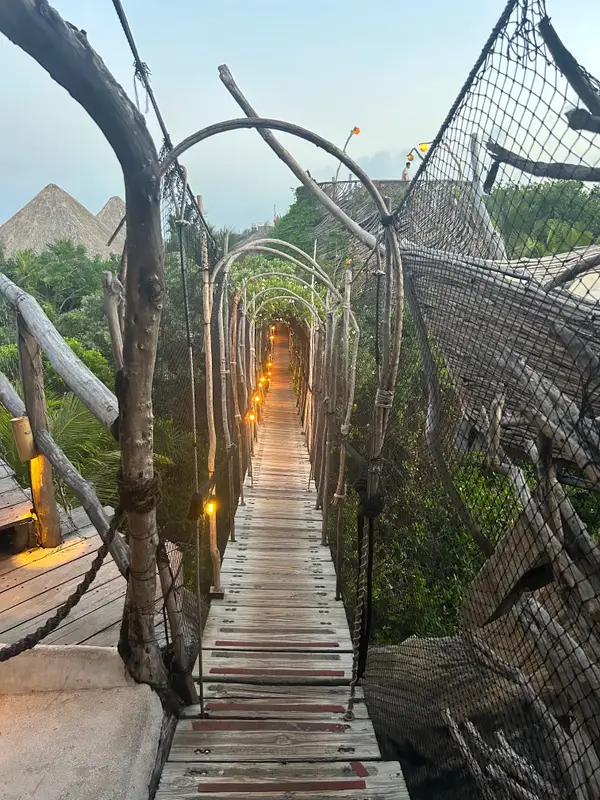
The bridge to Tseen Ja.
We walked across a swing bridge from Kin Toh to Tseen Ja, Azulik’s two on-site restaurants.
The design choice represents the “connection between Mexican and Japanese culture,” according to the website. I thought it was a sweet touch that added to the resort’s treehouse effect.
Our meal began with the yin and yang bao buns and truffle edamame.

The yin and yang bao buns at Tseen Ja.
The first dish — which cost 500 pesos, or about $25 — featured a white bao bun filled with delicious Kurobuta pork belly, its tender meat slick with a rich and savory sauce. But I thought the black bun, filled with crab, was strange. The texture was dry and crunchy, while the meat was tasteless.
We made up for the latter’s lack of flavor with the edamame, which cost 390 pesos, or about $19, came covered in truffles, and was packed with umami.
We also tried both bowls of ramen on the menu.
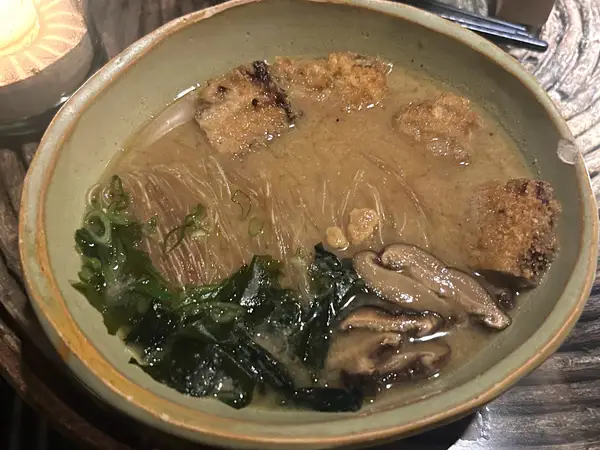
The miso kurobuta ramen at Tseen Ja.
The miso kurobuta ramen — which cost 1,120 pesos, or about $56 — featured a panko pork belly that was so soft and tender, its crispy skin soaking up the silky broth.
But the more expensive ramen shifudo, costing 1,300 pesos, or about $65, was almost inedible with its undercooked noodles and overwhelmingly fishy seafood stock.
Even with its beautiful setting, the food at Tseen Ja was a pricey disappointment.
Glowing orbs illuminated the resort’s stairs and pathways, guiding us on our walk back to the villa.

The pathways of Azulik at night.
When we walked through the door, our room was glowing in candlelight. It was a lovely and relaxing sight, especially right before bed.
We began the next morning by enjoying room service on our terrace.

Our small breakfast on the terrace.
While dinner had been a bust the night before, our Mayan hot chocolate and fresh “energizing” juice were both delicious.
My mom and I listened to the sounds of the crashing waves, soaking up our last few hours in Tulum as we ate the plate of fresh fruit.
We then headed over to Imix, Azulik’s private beach club.
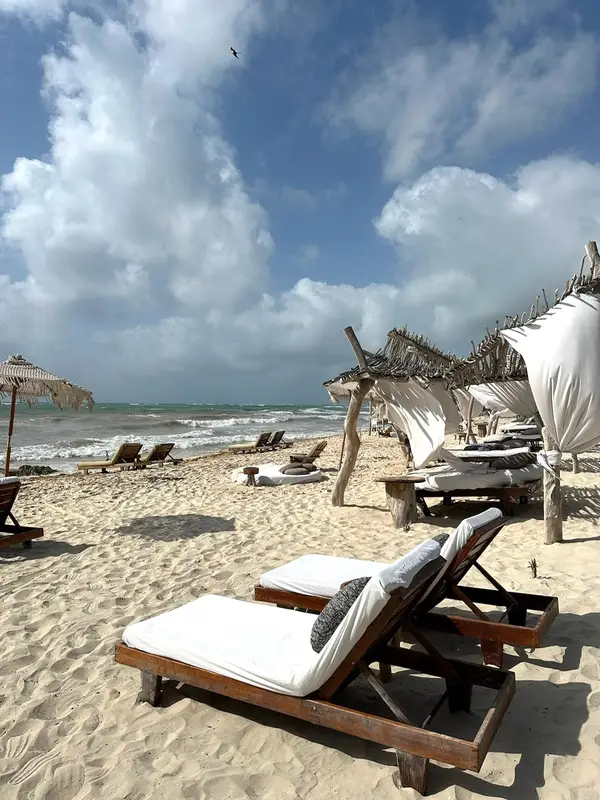
Azulik’s private beach club is clothing-optional.
The beach club was just opening as we made our way to Imix at 9 a.m., but the three friends we had seen at the “energy cleansing” ceremony were already filming content with their tripods.
The sand was dotted with comfortable sun loungers and daybeds, their plush white cushions glimmering under the hot sun. Pillows had been arranged to make the shape of a heart.
After soaking up some sun, we checked out Azulik’s stunning spa.
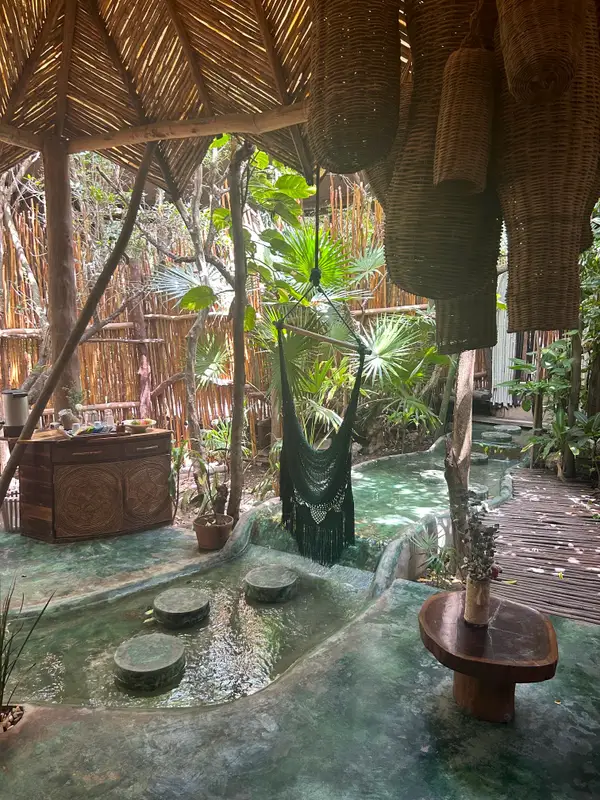
The spa at Azulik is beautifully designed.
The open-air spa was breathtaking, full of lush trees and glistening waterways. The extensive menu included the typical massages and facials, as well as temazcal and cacao ceremonies, sound healing, tarot and solar return readings, meditation classes, and more.
After strolling past all the massage beds the day before, my mom and I couldn’t resist booking a service. Our massage beds were set up by one of the cliffs overlooking the sea, and the experience was downright heavenly. It’s been months since our trip, and my mom and I still reminisce about those massages. They were among the best we’ve ever had.
They were also cheaper than I expected, costing 6,600 pesos, or around $330, for both services. Since the spa is open to non-guests, I highly recommend visiting it if you want some pampering on your next Tulum vacation.
Before checking out of the resort, we stopped by Kin Toh for lunch. Unfortunately, the food was just as disappointing as Tseen Ja.

Our plate of tacos at Kin Toh.
Like Tseen Ja, Kin Toh, located right under the rooftop, is beautifully designed. The restaurant’s many windows let you spot the tops of trees. The wooden tables are decorated with lovely runners, designed to look like sand dollars.
The beginning of lunch was promising as our frothy piña coladas and fresh guacamole arrived at the table. Then the tacos came out.
We tried four different tacos, costing between 220 to 230 pesos, or around $11. It’s quite the excessive price per taco, and they didn’t make up for it in flavor. The flank steak we tried was dry, the shrimp was flavorless, and everything lacked sauce. The only taco my mom and I kind of enjoyed was the chicken, which had been marinated in orange juice. We regretted only ordering one, but we had a plane to catch.
Stomachs still grumbling, our journey at Azulik had come to an end.
Azulik is a stunning place, but much of our experience felt like a tourist trap rather than a luxury resort.
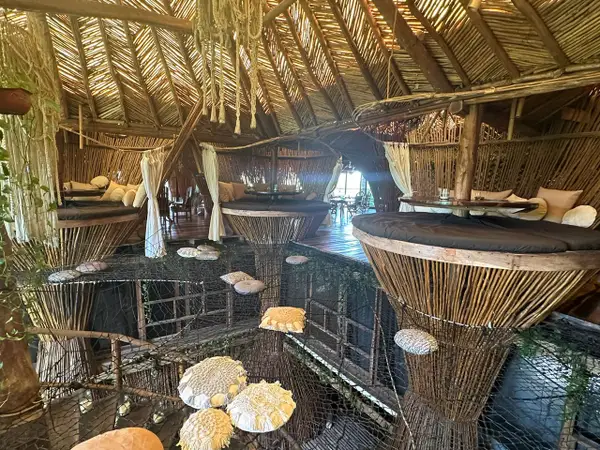
The entrance to Azulik’s Kin Toh restaurant.
There’s no denying that Azulik is beautifully designed. Walking over its waterways and climbing the stairs to its treehouse restaurants, I felt transported to a real jungle escape.
However, the food was nowhere near the quality of what a luxury resort should offer, especially at such exorbitant prices. The hidden fees and emphasis on VIP nests also felt like the resort was just trying to make as much money off its guests as possible.
The spa was a lovely experience, though. It’s a much better way to see the resort as a non-guest than going to sunset hour or eating at one of the restaurants.
They say a picture’s worth a thousand words. But at Azulik, there’s far more to the story than what you see on Instagram.






